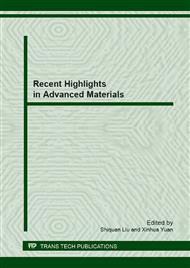p.91
p.95
p.101
p.107
p.111
p.116
p.123
p.130
p.137
Formation and Mechanical Properties of Instrument Panel Skins Produced by PVC Powder Slush Molding Processes
Abstract:
The compositions of PVC slush powder are determined by means of gel permeation chromatography (GPC) and pyrolysis gas chromatography/mass spectrometry (PGC-MS) methods after its separation and purification. The melt and combination of the powder during the formation processes of the slush molded skins are observed by polarizing microscope experiments. Dynamic mechanical analysis (DMA), stress relaxation experiments and Haward model are then used to study the physical and mechanical properties of the skin. It is found that the powder contains abundant phthalate and trimellitate plasticizers because of which the glass transition temperature Tg of the skin is quite low. There is a critical temperature above which the melt and combination of the powder accelerate. Stress relaxation experiments can eliminate the interference of viscous force. Based on that, the network structure of the skin and its Gaussian modulus can be well represented by Haward model.
Info:
Periodical:
Pages:
111-115
Citation:
Online since:
September 2013
Authors:
Keywords:
Price:
Сopyright:
© 2014 Trans Tech Publications Ltd. All Rights Reserved
Share:
Citation:


